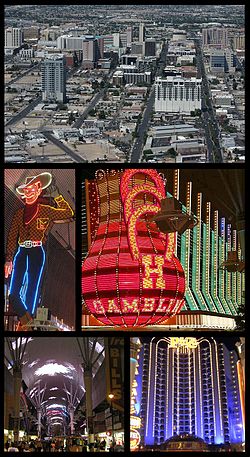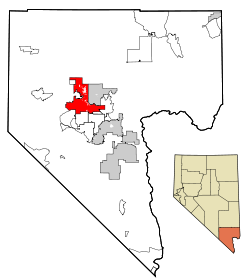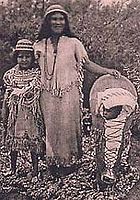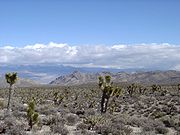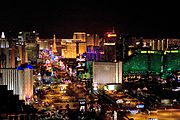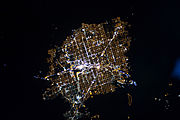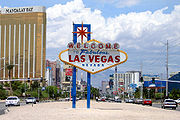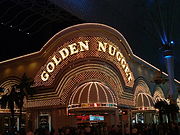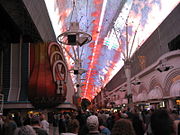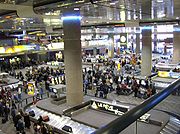
Las Vegas
Did you know...
SOS Children has tried to make Wikipedia content more accessible by this schools selection. Click here to find out about child sponsorship.
| Las Vegas | |||
|---|---|---|---|
| — City — | |||
| City of Las Vegas | |||
| A montage of the City of Las Vegas; From top to bottom: Las Vegas, Vegas Vic, Binion's Horseshoe, Fremont Street Experience, and Plaza Hotel & Casino | |||
|
|||
| Nickname(s): "The Entertainment Capital of the World" "Sin City" "Capital of Second Chances" "The Marriage Capital of the World" |
|||
| Location of Las Vegas in Clark County, Nevada | |||
|
|
|||
| Coordinates: 36°10′30″N 115°08′11″W | |||
| Country | US | ||
| State | Nevada | ||
| County | Clark County | ||
| Government | |||
| • Type | Council-Manager | ||
| • Mayor | Oscar B. Goodman ( N.P.) | ||
| • City Manager | Betsy Fretwell | ||
| Area | |||
| • City | 131.3 sq mi (340.0 km2) | ||
| • Land | 131.2 sq mi (339.8 km2) | ||
| • Water | 0.1 sq mi (0.16 km2) | ||
| Elevation | 2,001 ft (610 m) | ||
| Population (2009) | |||
| • City | 567,641 | ||
| • Density | 4,154/sq mi (1,604/km2) | ||
| • Urban | 1,314,356 | ||
| • Metro | 1,902,834 | ||
| ( 28 th U.S.) | |||
| Time zone | PST ( UTC−8) | ||
| • Summer ( DST) | PDT ( UTC−7) | ||
| ZIP codes | |||
| Area code(s) | 702 | ||
| FIPS code | 32-40000 | ||
| GNIS feature ID | 0847388 | ||
| Website | www.lasvegasnevada.gov | ||
Las Vegas (pronounced /lɑːs ˈveɪɡəs/) is the most populous city in Nevada, United States, the seat of Clark County, and an internationally renowned major resort city for gambling, shopping and fine dining. Las Vegas, which bills itself as The Entertainment Capital of the World, is famous for the number of casino resorts and associated entertainment. A growing retirement and family city, it is the 28th most populous city in the United States with an estimated population by the U.S. Census Bureau of 567,641 as of 2009. The 2009 population estimate of the Las Vegas metropolitan area was 1,902,834.
Established in 1905, Las Vegas officially became a city in 1911. With the growth that followed, at the close of the century Las Vegas was the most populous American city founded in the 20th century (a distinction held by Chicago in the 19th century). The city's tolerance for various forms of adult entertainment earned it the title of Sin City, and this image has made Las Vegas a popular setting for films and television programs. There are numerous outdoor lighting displays on Fremont Street, as well as elsewhere in the city.
The name Las Vegas is often applied to unincorporated areas that surround the city, especially the resort areas on and near the Las Vegas Strip. The 4.2 mi (6.8 km) stretch of Las Vegas Boulevard known as the Strip is mainly in the unincorporated communities of Paradise and Winchester, while a small portion overlaps into Las Vegas and the unincorporated community of Enterprise.
History
The first reported visit to the valley by someone of European descent was Raphael Rivera in 1829. Las Vegas was named by Spaniards in the Antonio Armijo party, who used the water in the area while heading north and west along the Old Spanish Trail from Texas. In the 19th century, areas of the Las Vegas Valley contained artesian wells that supported extensive green areas or meadows (vegas in Spanish), hence the name Las Vegas.
John C. Frémont traveled into the Las Vegas Valley on May 3, 1844, while it was still part of Mexico. He was a leader of a group of scientists, scouts and observers for the United States Army Corps of Engineers. On May 10, 1855, following annexation by the US, Brigham Young assigned 30 missionaries of The Church of Jesus Christ of Latter-day Saints led by William Bringhurst to the area to convert the Paiute Indian population to Mormonism. A fort was built near the current downtown area, serving as a stopover for travelers along the " Mormon Corridor" between Salt Lake and the briefly thriving colony of saints at San Bernardino, California. However, during the Utah War, Mormons abandoned Las Vegas in 1857. Las Vegas was established as a railroad town on May 15, 1905, when 110 acres (44.5 ha) owned by the San Pedro, Los Angeles and Salt Lake Railroad, was auctioned off in what is now downtown Las Vegas. Among the railroad's most notable owners and directors were Montana Senator William A. Clark, Utah U.S. Senator Thomas Kearns and R.C. Kerens of St. Louis. Las Vegas was part of Lincoln County until 1908 when it became part of the newly established Clark County. The St. Joan of Arc Catholic Church near 4th and Bridger in downtown was founded in 1910. Las Vegas became an incorporated city on March 16, 1911 and Peter Buol was the first mayor.
Las Vegas started as a stopover on the pioneer trails to the west, and became a popular railroad town in the early 20th century. It was a staging point for all the mines in the surrounding area, especially those around the town of Bullfrog, that shipped their goods out to the rest of the country. With the proliferation of the railroads, Las Vegas became less important but the completion of the nearby Hoover Dam in 1935 resulted in the growth of residents and tourism. The dam, located 30 mi (48 km) southeast of the city, also formed Lake Mead, the US's largest man-made lake and reservoir. Today, tours are offered into lesser known parts of the dam. The legalization of gambling in 1931 led to the advent of the casino-hotels, for which Las Vegas is famous. Major development occurred in the 1940s. The success of the city's early casino businesses was owed to American organized crime. Most of the original large casinos were managed or at least funded under mob figures Benjamin "Bugsy" Siegel, Meyer Lansky or other mob figures at this time. The rapid growth of this gambling empire is credited with dooming Galveston, Texas; Hot Springs, Arkansas; and other major gaming centers in the 1950s.
With the arrival in the late 1960s of businessman Howard Hughes, who purchased many casino-hotels, as well as television and radio stations in the city, legitimate corporations began to purchase casino-hotels as well, and the mob was run out by the federal government over the next several years. The constant stream of tourist dollars from the hotels and casinos was also augmented by a new source of federal money. This money came from the establishment of what is now Nellis Air Force Base. The influx of military personnel and casino job-hunters helped start a land building boom which, as of today, has leveled off a bit.
Though Las Vegas's gambling revenues have been surpassed by Macau, the Las Vegas area remains one of the world's top entertainment destinations.
Geography and climate
Las Vegas is situated on the arid desert floor within Clark County. The surrounding environment is dominated by desert vegetation and some wildlife, and the area is subject to torrential flash floods. Enabling the rapid population expansion was a major addition to the city's sewage treatment capacity. The sewage treatment expansion resulted from a U.S. Environmental Protection Agency grant funding 2008 programs to analyze and forecast growth and environmental impacts through the year 2019.
The city is in an arid basin surrounded by dry mountains. City elevation is around 2,030 ft (620 m) above sea level. The Spring Mountains lie to the west. Much of the landscape is rocky and dusty. Within the city, however, there are many lawns, trees and other greenery. Due to water resource issues, there is now a movement to encourage xeriscapes. Another part of the water conservation efforts include scheduled watering groups for watering residential landscaping. According to the United States Census Bureau, the city has a total area of 131.3 sq mi (340 km2), of which 131.2 sq mi (340 km2) is land and 0.1 sq mi (0.26 km2) of it (0.04%) is water.
Climate
Las Vegas' climate is a subtropical arid climate (Koppen climate classification BWh), typical of the Mojave Desert in which it lies. The city enjoys abundant sunshine year-round and has an average of about 300 sunny days per year and more than 3800 hours of sunshine, with about 4.2 inches of rainfall, which on average occurs on 29 days per year.
The summer months of June through September are very hot and mostly dry with average daytime highs of 94 to 104 °F (34 to 40 °C) and night-time lows of 69–78 °F (21–26 °C). There are an average of 133 days per year above 90 °F (32 °C), and 72 days above 100 °F (38 °C), with most of the days in July and August exceeding that benchmark. However, humidity is very low and often under 10%.
Las Vegas' winters are of short duration and the season is generally mild, with daytime highs near 60 °F (16 °C) and nighttime lows around 40 °F (4 °C). The mountains surrounding Las Vegas accumulate snow during the winter but snow is rare in the Las Vegas Valley itself. Several years apart, however, snow has fallen in the valley. Temperatures can sometimes drop to freezing 32 °F (0 °C) but winter nighttime temperatures will rarely dip below 30 degrees.
Annual precipitation in Las Vegas is roughly 4.5 in (110 mm). Most of the precipitation falls in the winter, but the driest month (June) has only 2.9 fewer average days of precipitation than the wettest month (March).
| Climate data for Las Vegas (McCarran International Airport) | |||||||||||||
|---|---|---|---|---|---|---|---|---|---|---|---|---|---|
| Month | Jan | Feb | Mar | Apr | May | Jun | Jul | Aug | Sep | Oct | Nov | Dec | Year |
| Record high °F (°C) | 77 (25) |
87 (31) |
92 (33) |
99 (37) |
109 (43) |
116 (47) |
117 (47) |
116 (47) |
113 (45) |
103 (39) |
87 (31) |
78 (26) |
117 (47) |
| Average high °F (°C) | 57.1 (13.9) |
63 (17.2) |
69.5 (20.8) |
78.1 (25.6) |
87.8 (31) |
98.9 (37.2) |
104.1 (40.1) |
101.8 (38.8) |
93.8 (34.3) |
80.8 (27.1) |
66 (18.9) |
57.3 (14.1) |
79.9 (26.6) |
| Average low °F (°C) | 36.8 (2.7) |
41.4 (5.2) |
47 (8.3) |
53.9 (12.2) |
62.9 (17.2) |
72.3 (22.4) |
78.2 (25.7) |
76.7 (24.8) |
68.8 (20.4) |
56.5 (13.6) |
44 (6.7) |
36.6 (2.6) |
56.3 (13.5) |
| Record low °F (°C) | 8 (−13) |
16 (−8.9) |
19 (−7.2) |
31 (−0.6) |
38 (3) |
48 (9) |
56 (13) |
54 (12) |
43 (6) |
26 (−3.3) |
15 (−9.4) |
11 (−12) |
8 (−13) |
| Precipitation inches (mm) | 0.59 (15) |
0.69 (17.5) |
0.59 (15) |
0.15 (3.8) |
0.24 (6.1) |
0.08 (2) |
0.44 (11.2) |
0.45 (11.4) |
0.31 (7.9) |
0.24 (6.1) |
0.31 (7.9) |
0.4 (10.2) |
4.49 (114) |
| Avg. precipitation days (≥ 0.01 in) | 3.4 | 3.5 | 3.6 | 1.8 | 1.6 | 0.7 | 2.6 | 3 | 1.9 | 1.8 | 1.8 | 2.9 | 28.6 |
| Mean monthly sunshine hours | 244.9 | 248.6 | 313.1 | 345 | 387.5 | 402 | 390.6 | 368.9 | 336 | 303.8 | 246 | 235.6 | 3822 |
| Source #1: NOAA | |||||||||||||
| Source #2: HKO (sun only) | |||||||||||||
Demographics
| Historical populations | |||
|---|---|---|---|
| Census | Pop. | %± | |
| 1900 | 25 |
|
|
| 1910 | 800 | 3,100.0% | |
| 1920 | 2,304 | 188.0% | |
| 1930 | 5,165 | 124.2% | |
| 1940 | 8,422 | 63.1% | |
| 1950 | 24,624 | 192.4% | |
| 1960 | 64,405 | 161.6% | |
| 1970 | 125,787 | 95.3% | |
| 1980 | 164,674 | 30.9% | |
| 1990 | 258,295 | 56.9% | |
| 2000 | 478,434 | 85.2% | |
| Est. 2009 | 567,641 | ||
| source: | |||
According to the 2006–2008 American Community Survey, the racial composition of Las Vegas was as follows:
- White: 70.8% ( Non-Hispanic Whites: 50.8%)
- Black or African American: 10.3%
- Native American: 0.6%
- Asian: 5.5%
- Native Hawaiian and Other Pacific Islander: 0.5%
- Some other race: 8.8%
- Two or more races: 3.6%
- Hispanic or Latino (of any race): 30.0%; Mexican Americans made up 27.8% of the city's population.
Source:
As of the census of 2000, there were 478,434 people, 176,750 households, and 117,538 families residing in the city. The population density was 4,222.5 /sq mi (1,630.3 /km2). There are 190,724 housing units at an average density of 1,683.3 /sq mi (649.9 /km2). The racial makeup of the city was 69.9% White, 10.4% African American, 0.8% Native American, 4.8% Asian, 0.5% Pacific Islander, 9.8% from other races, and 4.1% from two or more races. Hispanic or Latino of any race were 23.6% of the population.
There were 176,750 households out of which 31.9% had children under the age of 18 living with them, 48.3% were married couples living together, 12.2% had a female householder with no husband present, and 33.5% were non-families. 25.0% of all households were made up of individuals and 7.5% had someone living alone who was 65 years of age or older. The average household size was 2.66 and the average family size was 3.20.
In the city the population was spread out with 25.9% under the age of 18, 8.8% from 18 to 24, 32.0% from 25 to 44, 21.7% from 45 to 64, and 11.6% who were 65 years of age or older. The median age was 34 years. For every 100 females there were 103.3 males. For every 100 females age 18 and over, there were 102.5 males.
The median income for a household in the city was $53,000 and the median income for a family was $58,465. Males had a median income of $35,511 versus $27,554 for females. The per capita income for the city was $22,060. About 6.6% of families and 8.9% of the population were below the poverty line, including 5.4% of those under age 18 and 6.3% of those age 65 or over.
Las Vegas has one of the highest suicide and divorce rates of the U.S. A research study that found Las Vegas residents are 40% less likely to commit suicide if they leave Las Vegas and visitors are more than twice as likely to commit suicide there as elsewhere was published in the Las Vegas Sun newspaper in 2008, breaking a long-time taboo on discussion of suicide in Las Vegas. The city's high divorce rate is not wholly due to Las Vegans themselves getting divorced. Since divorce is easier in Nevada than most other states, many people come from across the country for the easier process.
For similar reasons, Las Vegas has also one of the highest marriage rates of U.S. cities as well, with many licenses issued to people from outside the area (see Las Vegas weddings).
Economy
The primary drivers of the Las Vegas economy have been the confluence of tourism, gaming and conventions, which in turn feed the retail and restaurant industries. The city serves as world headquarters for the world's two largest Fortune 500 gaming companies, Harrah's Entertainment and MGM Resorts International. Several companies involved in the manufacture of electronic gaming machines, such as slot machines, are located in the Las Vegas area. In the first decade of the 21st century retail and dining have become attractions of their own. Tourism marketing and promotion are handled by the Las Vegas Convention and Visitors Authority, a county wide agency. Its annual Visitors Survey provides detailed information on visitor numbers, spending patterns and resulting revenues.
Constant population growth means that the housing construction industry is vitally important. In 2000 more than 21,000 new homes and 26,000 resale homes were purchased. In early 2005 there were 20 residential development projects of more than 300 acres (120 ha) each underway. During the that same period Las Vegas was regarded as the fastest growing community in the US. However, the financial crisis of 2007-2010 and the accompanying business downturn has sent business and growth tumbling, with Las Vegas recording one of the highest home foreclosure rates in the country. The disappearance of disposable consumer income and the backlash against corporate entertainment spending sent the hospitality industry into a tailspin that it has yet to fully recover from as of summer 2010.
Redevelopment
When The Mirage opened in 1989, it started a trend of further development of the southern portion of the Las Vegas Strip. This resulted in a drop in tourism in the downtown area but many recent projects and condominium construction have increased visitors to downtown.
A concerted effort has been made by city officials to diversify the economy from tourism by attracting light manufacturing, banking, and other commercial interests. The lack of state individual and corporate income tax and very simple incorporation requirements have fostered the success of this effort.
Las Vegas has recently enjoyed an enormous boom both in population and tourism. The urban area has grown outward so quickly that it is beginning to run into Bureau of Land Management holdings along its edges, increasing land values enough that medium- and high-density development is beginning to occur closer to the core. As a reflection of the city's rapid growing population, the new Chinatown of Las Vegas was constructed in the early 1990s on Spring Mountain Road. Chinatown initially consisted of only one large shopping centre complex, but the area was recently expanded for new shopping centers that contain various Asian businesses.
With the Strip expansion in the 1990s, the downtown area (which has maintained an old Las Vegas feel) began to suffer. The city made a concerted effort to turn around the fortunes of downtown. The Fremont Street Experience (FSE) was built in an effort to draw tourists back to the area and has proven to be popular in that regard. Since the recession began in 2008, many of these efforts have closed. The multi-level Neonopolis, closed their 11 theaters and nearly all retail stores. Many high-rise condo projects have also been underway but one of the highest profile buildings, The Streamline Towers, has gone into bankruptcy. Other promising signs emerged for the area. The city had successfully lured the Internal Revenue Service operations from the far west of the city to a new downtown building that opened in April 2005. The IRS move is expected to create a greater demand for additional businesses in the area, especially in the daytime hours.
The city purchased 61 acres (25 ha) of property from the Union Pacific Railroad in 1995 with the goal of creating something to draw more people to the downtown area. In 2004 Las Vegas Mayor Oscar Goodman announced plans for Symphony Park, which will include residential and office high-rises, the Lou Ruvo Brain Institute, an academic medical centre, The Smith Centre for the Performing Arts, and a new City Hall. After failed negotiations with The Related Co. on the development of Union Park in October 2005, San Diego-based Newland Communities was chosen by the city as the new development firm. The Newland contract calls for Dan Van Epp, Newland's regional vice president and former president of the Howard Hughes Corp., to oversee his company's work on Symphony Park. The Lou Ruvo Brain Institute was completed in 2009.
Along with the Symphony Park, other promising residential and office developments have begun construction around downtown Las Vegas. New condominium and hotel high rise projects have changed the Las Vegas skyline dramatically in recent years. Many large high-rise projects are planned for downtown Las Vegas as well as the Las Vegas Strip.
In 2004, the city partnered with Cheetah Wireless Technologies and MeshNetwork to pilot a wide area mobile broadband system. The pilot system is installed downtown, around the Fremont Street Experience. In 2005, on a lot adjacent to the city's 61 ac (247,000 m2), the World Market Centre opened. It is intended to be the nation's and possibly the world's preeminent furniture wholesale showroom]and marketplace, and is meant to compete with the current furniture market capital of High Point, North Carolina.
On October 23, 2006, plans were unveiled to build a World Jewelry Center in Downtown's Symphony Park. Similar to the World Market Centre, the WJC will be a one stop shop for jewelry trade shows from around the world. The project proposes a 57-story, 815 ft (248 m) office tower.
Tourism
The major attractions in Las Vegas are the casinos and the hotels. The most famous hotel casinos are located on Las Vegas Boulevard on the portion of that road known as the Las Vegas Strip. These larger casinos are located outside of the city. Many of these hotels are massive, providing thousands of rooms, with their large adjoining casino areas. There are many hotel casinos in the city's downtown area as well, which was the focal point of the city's gaming industry in its early days. Several large hotels and casinos are also located somewhat off the Strip, as well as in the county around the city.
Some of the most notable casinos involved in downtown gaming are on the Fremont Street Experience which was granted variances to allow bars to be closer together, similar to the Gaslamp Quarter of San Diego.
Downtown area casinos
- Binion's Gambling Hall and Hotel
- California Hotel and Casino
- El Cortez
- Fitzgeralds Las Vegas
- Four Queens
- Fremont Casino
- Gold Spike Hotel and Casino
- Golden Gate Hotel and Casino
- Golden Nugget
- Las Vegas Club
- Main Street Casino
- Plaza Hotel & Casino
Surrounding cities
- Henderson, Nevada, incorporated
- North Las Vegas, Nevada, incorporated
- Paradise, Nevada, unincorporated
- Enterprise, unincorporated
- Sunrise Manor, Nevada, unincorporated
- Spring Valley, Nevada, unincorporated
- Boulder City, Nevada, incorporated
Culture
On the first Friday of each month, the "First Friday" celebration is held which exhibits the works of local artists and musicians in a section of the city's Downtown region now called the "Arts District".
The Thursday prior to First Friday is known in the 18b Arts District as "Preview Thursday". This evening event highlights new gallery exhibitions just opening throughout the district.
The Southern Nevada Zoological-Botanical Park, also known as the Las Vegas Zoo, exhibits over 150 species of animals and plants.
The $485 million Smith Center for the Performing Arts (currently under construction) will be located downtown in Symphony Park. The centre will be appropriate for Broadway shows and other major touring attractions as well as orchestra, opera, and dance performances.
The city also hosts annual events like the Helldorado Days (Las Vegas).
Sports
Las Vegas does not have major-league sports, although the metropolitan population is as large or larger than many cities that have them. The two main reasons are concern about legal sports betting and competition for the entertainment dollar, both of which Las Vegas has in abundance. The only minor league sports team that plays in the City of Las Vegas is baseball's Las Vegas 51s, the AAA farm club of the Toronto Blue Jays, of the Pacific Coast League.
Parks and recreation
Las Vegas has dozens of parks, including Las Vegas Springs Preserve recreational and educational facility and Floyd Lamb State Park.
Attractions
Las Vegas is a popular destination for Hawaiians. In 2002, almost 80,000 former residents of Hawaii lived in Las Vegas, and nearly 3,000 Hawaiians visited Las Vegas every week. Las Vegas is sometimes referred to as Hawaii's Ninth Island. The city is the home to the first ABC Stores branch outside the state of Hawaii.
Government
The City of Las Vegas government operates as a council-manager government. The Mayor sits as a Council member-at-large and presides over all of the City Council meetings. In the event that the Mayor cannot preside over a City Council meeting, the Mayor Pro-Tem is the presiding officer of the meeting until such time as the Mayor returns to his seat. The City Manager is responsible for the administration and the day-to-day operation of all of the municipal services and city departments. The City Manager also maintains intergovernmental relationships with federal, state, county and other local governments.
Much of the Las Vegas metropolitan area is split into neighboring incorporated cities or unincorporated communities. Approximately 700,000 people live in unincorporated areas governed by Clark County, and another 465,000 live in incorporated cities such as North Las Vegas, Henderson and Boulder City. Las Vegas and nearly all of the surrounding metropolitan area share a police department, the Las Vegas Metropolitan Police Department, which was formed after a 1973 merger of the Las Vegas Police Department and the Clark County Sheriff's Department. North Las Vegas, Henderson, Boulder City as well as some colleges have their own police departments.
A Paiute Indian reservation occupies about one acre (4000 m2) in the downtown area of Las Vegas.
Las Vegas, as the county seat and home to the Lloyd D. George Federal District Courthouse, draws numerous legal service industries providing bail, marriage, divorce, tax, incorporation and other legal services.
City council
( Council members' official city websites are also available)
- Oscar B. Goodman – Mayor and Council member at Large (Term Expires in 2011)
- Gary Reese – Mayor Pro-Tem and 3rd Ward Council member (Term Expires in 2011)
- Lois Tarkanian – 1st Ward Council member (Term Expires in 2011)
- Steve Wolfson, Esq – 2nd Ward Council member (Term Expires in 2009)
- Stavros Anthony – 4th Ward Council member (Term Expires in 2013)
- Ricki Barlow – 5th Ward Council member (Term Expires in 2011)
- Steve Ross – 6th Ward Council member (Term Expires in 2009)
Education
Primary and secondary public education is provided by the Clark County School District (CCSD), which is the fifth most populous school district in the nation (projected enrollment for the 2007–2008 school year is 314,000 students in grades K–12).
Transportation
RTC Transit is a public transportation system providing bus service throughout Las Vegas, Henderson, North Las Vegas and other suburban areas of the valley. Intercity bus service to Las Vegas is provided by traditional intercity bus carriers, including Greyhound; many charter services, including Green Tortoise; and several Chinatown bus lines. Amtrak California also operates Deluxe Express Thruway Motorcoach dedicated service between the City and its passenger rail station in Bakersfield, California.
A new bus rapid transit link in Las Vegas called the ACE Gold Line (a bus route with limited stops and frequent service) was launched in March 2010, and connects Downtown Las Vegas, the Strip, the Las Vegas Convention Centre, and Town Square.
With some exceptions, including Las Vegas Boulevard, Boulder Highway (SR 582), and Rancho Drive (SR 599), the majority of surface streets in Las Vegas are laid out in a grid along Public Land Survey System section lines. Many are maintained by the Nevada Department of Transportation as state highways. The street numbering system is divided by the following streets:
- Westcliff Drive, US 95 Expressway, Fremont Street and Charleston Boulevard divide the north-south block numbers from west to east.
- Las Vegas Boulevard divides the east-west streets from the Las Vegas Strip to near the Stratosphere, then Main Street becomes the dividing line from the Stratosphere to the North Las Vegas border, after which the Goldfield Street alignment officially divides east and west.
- On the east side of Las Vegas, block numbers between Charleston Boulevard and Washington Avenue are different along Nellis Boulevard, which is the eastern border of the city limits.
Interstates 15, 515, and US 95 lead out of the city in all four directions. Two major freeways – Interstate 15 and Interstate 515/ U.S. Route 95 – cross in downtown Las Vegas. I-15 connects Las Vegas to Los Angeles, CA and heads northeast to and beyond Salt Lake City, Utah. I-515 goes southeast to Henderson, beyond which US 93 continues over the Hoover Dam towards Phoenix, Arizona. US 95 connects the city to northwestern Nevada, including Carson City and Reno. US 93 splits from I-15 northeast of Las Vegas and goes north through the eastern part of the state, serving Ely and Wells, and US 95 heads south from US 93 near Henderson through far eastern California. A partial beltway has been built, consisting of Interstate 215 on the south and Clark County 215 on the west and north. Other radial routes include Blue Diamond Road (SR 160) to Pahrump and Lake Mead Boulevard (SR 147) to Lake Mead.
- East-west roads, north to south
- North-south roads, west to east
McCarran International Airport handles international and domestic flights into the Las Vegas Valley. The airport also serves private aircraft and freight/cargo flights. Some of the general aviation traffic uses the smaller North Las Vegas Airport and Henderson Executive Airport.
The Union Pacific Railroad is the only class one railroad to provide rail freight service to the city. Until 1997, the Amtrak Desert Wind train service ran through Las Vegas using the Union Pacific Railroad tracks that run through the city. Amtrak service to Las Vegas goes to Needles, California and continues on Amtrak's Thruway Motorcoach bus service. Plans to restore Los Angeles to Las Vegas Amtrak service using a Talgo train were discussed in the late 1990s but no plan for a replacement was ever implemented. The Las Vegas Amtrak station was located in the Plaza Hotel; it held the distinction of being the only train station in the US that was located in a casino.
Proposals to revive passenger trains to Las Vegas have included the Desert Xpress high-speed train from Victorville, California; the California-Nevada Interstate Maglev which would extend eventually to Anaheim, California with its first segment being to Primm, Nevada; the Las Vegas Railway Express; and most recently, the Z-Train which would travel six days a week between Los Angeles Union Station and a new Z-Train Station adjacent to the Strip.
Sister cities
Las Vegas has several sister cities, as designated by Sister Cities International:
 Ansan, South Korea
Ansan, South Korea Jeju City, South Korea
Jeju City, South Korea Huludao, Liaoning, China
Huludao, Liaoning, China Pernik, Bulgaria
Pernik, Bulgaria Phuket, Thailand
Phuket, Thailand Angeles City, Philippines
Angeles City, Philippines Pamukkale, Turkey
Pamukkale, Turkey
